Bottle Recycling Department of a Brewery
On this page
- What kinds of work do people do in the bottle recycling department of a brewery?
- What are some health and safety hazards for persons who work in bottle recycling?
- What are the tasks involved in "throw on"?
- What are the risk factors of the throw on operation?
- What are the tasks involved in the bottom saw operation?
- What are the risk factors of the bottom saw operation?
- What is housekeeping?
- What are the tasks involved in the on caser operation?
- What are the risk factors of the on caser operation?
- What are the tasks involved in rejects?
- What are the risk factors of rejects?
- How can we reduce the risk factors for RMI?
What kinds of work do people do in the bottle recycling department of a brewery?
Back to topThe work in this case study of a bottle recycling department consists of three core operations:
- Throw on
- Bottom saw
- Utilities or housekeeping
There are two additional operations: "On caser" and "Rejects". These jobs happen once or twice every day for a short period. Four workers are employed in the bottle recycling department.
What are some health and safety hazards for persons who work in bottle recycling?
Back to top- Possible noise exposure.
- Slips, trips, and falls.
- Stress.
- Shift work or extended work days.
- Working in a standing position.
In addition to some of the hazards listed above, pain or injury from physical overexertion, repetitive manual tasks, or working in awkward positions is very common. A case study is presented below.
Please also see the OSH Answers on Conveyors – ergonomics for more information.
What are the tasks involved in "throw on"?
Back to topThe "throw on" operation consists of unloading pallets with boxes filled with empty beer bottles (Figure 1).
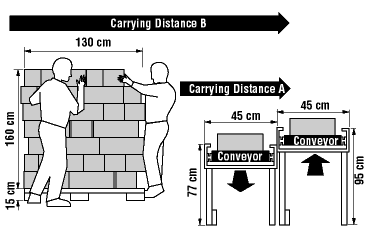
Figure 1
To complete the task a worker has to:
- Reach for the boxes.
- Grasp the boxes, containing up to 48 bottles (Figure 2) with a pinch grip, squeeze grip, hook grip, or another grip.
- Lift and carry the boxes to a conveyor (Figure 3) two-handed for one load, or one-handed for one load, or two-handed for two loads.
- Release the boxes onto a conveyor.
- Move back to the pallet.
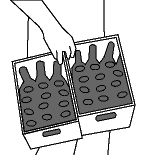
Figure 2
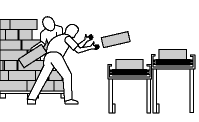
Figure 3
The pace of the work is dictated by the moving conveyor. The task lasts between 2 to 5 seconds, according to the lifting technique used. One pallet is emptied in about three minutes. Two workers rotate to this task every 30 minutes.
What are the risk factors of the throw on operation?
Back to topThe parts of the job that create risk for repetitive motion injuries (RMIs) on the throw on are:
- lifting
- bodily motions
- grasping and handling boxes with bent wrists
- working while standing and walking on a hard floor
On the "throw on" alone, a worker usually lifts 6.8 kg (approximately 15 lbs) every lift. One worker lifts approximately 190 kg (418 lbs) every three minutes for a total of about 1,500 kg (3,300 lbs) every rotation and about 7,000 kg (15,400 lbs) every day.
According to the National Institute for Occupational Safety Health (NIOSH) guide for manual lifting , the recommended weight limit for the "throw on" operations would be:
- Lifting from the top of the pallet (Figure 4) 0.53 kg (1.16 lbs)
- Lifting from waist level 1.32 kg (2.90 lbs)
- Lifting from the bottom (Figure 5) 0.56 kg (1.23 lbs)
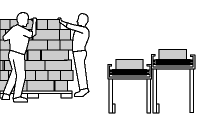
Figure 4
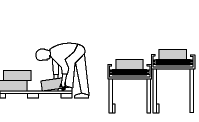
Figure 5
Comparison of the actual lift of 6.8 kg (15 lbs) to the NIOSH limits shows that workers are exposed to severe lifting which exceeds recommended weight limits by up to 10 times.
In addition, excessive bodily motion to complete this task results in an energy expenditure of about 7 kcal/min. This rate makes "throw on" a task that requires very heavy effort. Lifting the boxes also puts workers at risk for low back pain.
The frequency of lifting, the unique configuration of the workplace, and the technique of lifting make up a specific risk for RMI. Lifting up to 6.8 kg, combined with very stressful grasps (pinch grip, squeeze grip, etc.), puts a lot of strain on the upper limbs and especially on the wrist. Throwing boxes onto the conveyor also creates risk for RMI. Working in a standing position (standing, walking) can cause discomfort to the lower legs, contributing also to the feeling of overall fatigue.
What are the tasks involved in the bottom saw operation?
Back to topThe bottom saw operation consists of removing the cardboard boxes so that empty beer bottles can be washed and reused. The operation begins with cutting the bottom out of the cardboard boxes. To complete the task a worker has to:
- Reach for bottomless boxes on the conveyor (Figure 6).
- Grasp boxes with a pinch grip.
- Lift and throw boxes (Figure 7).
- Operate the control panel for the conveyor.
The "bottom saw" operation requires the worker to remain standing in a very restricted position. Arms are constantly elevated above elbow level (Figure 8).
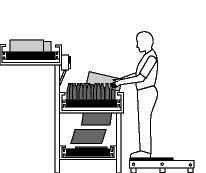
Figure 6
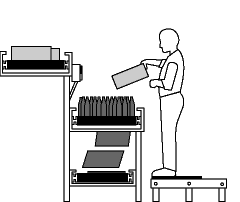
Figure 7
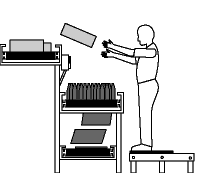
Figure 8
When the worker is throwing boxes onto the conveyor, the arms reach and go above shoulder level. The fast pace of work is dictated by the moving conveyor. The task lasts approximately 1 to 2 seconds. One worker rotates to this task every 15 minutes.
What are the risk factors of the bottom saw operation?
Back to topWork components on the bottom saw operation that create risks for RMI include:
- highly repetitive movements - one task lasts only 1 to 2 seconds
- the fixed standing position that the worker maintains for about 15 minutes
- forceful movements while throwing
- throwing the boxes with a pinch grip and bent wrists
Wrists, arms, shoulders and neck are at the highest risk. Additionally, working conditions on the "bottom saw" can contribute to low back and lower leg discomfort that over time can develop into injury.
What is housekeeping?
Back to topHousekeeping is carried out by one worker who rotates to this task every 15 minutes. It combines many activities involving whole body movements. The pace of work is self-imposed. This task can be physically intensive because of how much energy is required to do it. Still, the task gives workers a type of muscle relief. The housekeeping task at this facility was determined to not be particularly hazardous for repetitive motion injuries.
What are the tasks involved in the on caser operation?
Back to topThe on caser operation consists of feeding the conveyor with boxes containing 24 empty beer bottles. One worker collects the cardboard boxes, and the second worker feeds the conveyor, similar to the "throw on" operation.
To complete the task the worker has to:
- Reach for empty boxes from the conveyor (Figure 9).
- Arrange boxes in bundles of four (Figure 10).
- Pile boxes on a pallet.
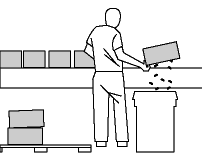
Figure 9
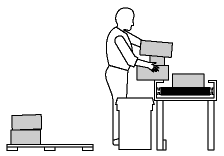
Figure 10
The speed of the task is dictated by the moving conveyor. The task lasts approximately 5 seconds.
What are the risk factors of the on caser operation?
Back to topDoing the on caser operation requires working in restricted body positions. The work height is between elbow and shoulder level. As well, there is a great deal of bending and twisting of the upper body. These create the risk for repetitive motion injuries.
The on caser operation is done only occasionally but the type of movements required are similar to some used for the "throw on" and "bottom saw" operations. Therefore, the "on caser" operation does not give workers any variety of movements when they are away from the other tasks.
What are the tasks involved in rejects?
Back to topThe rejects operation consists of retrieving bottles of unusual sizes from a conveyor and loading the bottles in boxes (Figure 11).
This task is carried out once or twice every day. To complete the task, a worker has to:
- Reach for empty bottles.
- Grasp bottles.
- Place bottles in boxes.
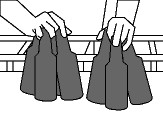
Figure 11
What are the risk factors of rejects?
Back to topWorkers use highly repetitive movements while doing this task. They also overreach forward and sideways and use forceful movements to grasp the bottles. This combination of movements creates stress on the neck, shoulders, wrists and arms. Prolonged standing on a hard floor adds stress to the legs and back.
How can we reduce the risk factors for RMI?
Back to topThe three main tasks in this recycling department represent three significantly different types of work that expose workers to different health hazards.
- The throw on operation, with excessive lifting and extreme body motion, creates the risk for back injury.
- The bottom saw operation is a classic example of a workplace with a high risk for injuries of the wrists, arms, neck and shoulders.
- Housekeeping, although physically demanding, does not create any particular hazard for repetitive motion injuries for fit and well-conditioned individuals.
These different tasks require different approaches. Workers should continue to rotate to other tasks.
Throw on
The throw on is a high risk operation for back injuries as well as to the wrists, neck and shoulders. Workers are exposed to heavy lifting, repetitive and forceful movements, and awkward body positions.
Manual lifting cannot be fully eliminated; however, it is possible to reduce the effort of lifts from above shoulder and floor level by adjusting the height of the pallet to be always between waist and shoulder level (Figure 12).
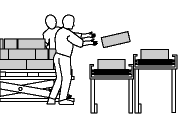
Figure 12
A lifting table for the pallet would reduce bending and overreaching (Figure 12). To reduce twisting and carrying distance, it would be desirable to place the pallets closer to the conveyor.
The suggested improvements will reduce the effort required to lift boxes. It is still important to keep the weight of the loads below the level suggested by the NIOSH Guide for Manual Lifting.
Bottom saw
Workers involved in the bottom saw operation are exposed to awkward body positions. Forceful and repetitive movements are also used when throwing the boxes for disposal.
To reduce awkward postures, it is necessary to elevate the worker so that he can grasp the boxes at the waist height (Figure 13). To ease the effort for throwing the boxes for disposal, it is necessary to lower the height of the conveyor belt transporting the boxes (Figure 13). Workers should have a foot rail so they can shift the weight of their bodies.
They should also have a chair or a sit/stand stool (Figure 14) to reduce the stress on the body from standing. To benefit fully from a sit/stand stool, workers should have a firm foot support.
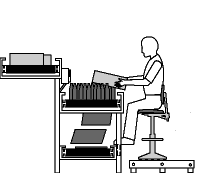
Figure 13
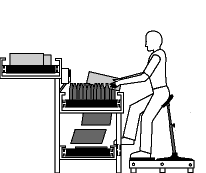
Figure 14
On caser
Workers involved in the on caser operation are exposed to repetitive movements and awkward body positions such as working with elevated arms and bending and twisting.
To reduce the repetitive pattern of the work, it is essential to rotate workers to other tasks.
- To reduce bending, it is necessary to place the pallet on a lifting table (Figure 15).
- To reduce twisting while piling boxes on the pallet, place the pallet beside the worker (Figure 16).
- To reduce stress on the legs and back due to prolonged standing, use anti-fatigue matting.
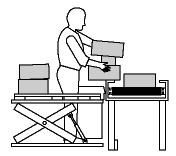
Figure 15
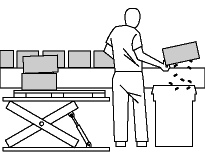
Figure 16
Rejects
Workers involved in the rejects operation are exposed to repetitive movements and awkward body positions.
To reduce awkward body positions such as overreaching, it is necessary to install a funneling device on the conveyor. This device directs the bottles to the half of the conveyor closest to the worker (Figure 17).
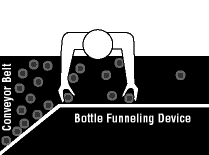
Figure 17
This funneling device reduces the capacity of the area that collects bottles. In this case, the bottles have to be removed more often. The fact that there are fewer bottles on the conveyor at a time may encourage the worker to use a slower pace of work. To reduce stress on the legs and back due to standing on a hard floor, use anti-fatigue matting.
General Recommendation
Workers in the bottle recycling department should continue to do different tasks to change body positions and use different parts of the body. However, all the tasks, except housekeeping, are very similar in nature, and do not give workers muscle relief.
As a general strategy, the workload should be evenly distributed among the four workers. This distribution can be accomplished by rotating workers to other tasks. The rotation could be organized so that each worker spends 15 minutes every hour doing housekeeping activities. This task is not particularly hazardous for repetitive motion injuries. It allows workers to impose their own pace of work. It also allows workers to use different groups of muscles.
Acknowledgment
The Canadian Centre for Occupational Health and Safety in cooperation with the Government of Newfoundland and Labrador, Department of Employment and Labour Relations, Occupational Health and Safety Branch would like to acknowledge the participation of the Labatt Breweries of Newfoundland (A Division of Labatt Brewing Co. Ltd.) who so freely gave their time and resources to assist us in the development of this case study.
- Fact sheet confirmed current: 2022-02-28
- Fact sheet last revised: 2022-02-28

